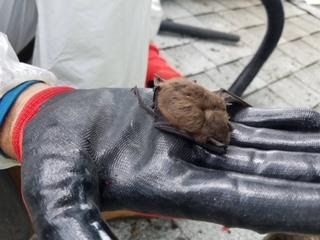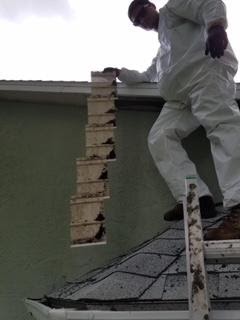
How to Hire a Professional to Remove Bats
In today’s fast growing world, people have so many more options and choices in almost all areas of life; it can even be overwhelming for some. These choices can range from furniture and electronics, to many Do It Yourself items that can be assembled by yours truly. DIY projects are becoming more and more popular these days as people look for ways to save money by not having to hire a professional to do whatever the work may be, some things though we should continue to leave to the professionals. Most people have assembled a piece of living room furniture at one time or another but I guarantee most have not performed surgery; we tend to leave that to the pros. It goes without saying that somethings you are better not doing yourself, in this blog we are going to explore the options that one has when performing bat removal in Melbourne and Palm Bay Florida and the recommendations we have for solving whatever issue you may have.
As we briefly talked about, there are certain things that need to be done by professionals due to the skill required to complete the task, the equipment needed for completion, or perhaps the danger involved in the job. We are here to educate the public on these matters and our area of expertise is in wildlife removal, especially bat removal. Let’s clear the air real quick and say we never recommend doing it yourself when dealing with a bat issue in your home or business, this is a job for the professionals. If you are currently dealing with an issue of your own, do not attempt this and please call a professional wildlife removal company to help out, we don’t want anyone getting sick or hurt. We will also tell you that there are many things to look out for when hiring a professional company and we want to help make that choice as painless as possible by giving a few key things to look for before hiring anyone, let’s take a closer look.
License and Insurance
Whenever considering hiring a bat removal company, or any company for that matter, always make sure they are licensed and insured, this will give you the peace of mind knowing that you and your home are protected in case of damage, injury, or anything else that may go wrong. Never and we repeat never hire a company that is not licensed and insured, you are only putting yourself at risk and we never recommend this option. There are plenty of companies out there that are not licensed and insured and although they may be able to perform a bat removal without a hitch, if something were to happen or if they were to damage your house, you would have no way to deal with this. Making sure a company is licensed not only gives you the peace of mind knowing your home is protected when getting work done on it, but this also ensure that the company that you hired is perform the job in a safe humane way using best practices. As the saying goes, “There is more than one way to skin a cat” and this is true in the wildlife industry as well. There are safe and effective ways of removing bats from a home and there are dangerous and ineffective ways of doing it, hiring a company that is licensed and insured will make sure best practices are used. We said earlier that you want to hire a company that performs humane bat removal but what exactly does that mean? Let’s explore and take a closer look.
Humane Bat Removal
Imagine you are a homeowner in the Melbourne, Palm Bay, Viera or Suntree area of central Florida, every night as you enjoy the wonderful weather outside, you begin to notice consistent a large number of bats that always seem to be flying around your home at dusk or just before sunrise. You do some investigation and figure out that these bats not only like flying around your home, but they enjoying nesting in it as well, Uh-Oh, what to do now. We know that the first thing to do is find a licensed and insured company to come out and perform an inspection. They will be able to pinpoint the problem areas on your home that either already have bats living inside or could potentially become a home for them in the future.

Alright, so you know where the bats are living now and where they could potentially live in the future, but now it is time to remove them, we want you to understand how this is performed so you can make sure the company you hired is doing this the same way. Bats tend to enjoy living in taller structures with plenty of cover and shelter from the elements. They tend to nest inside roof returns with soffit openings, gaps in a home’s vinyl or wood siding, inside gable vents and cupolas, as well as any structure on a home that gives height and shelter to the bats. Homes are built differently so some homes may have more potential nesting spots than others, but it is very important to identify all red flag areas in order to perform a complete animal seal up of the home. Once we have located all the spots, now it is time to begin the professional seal up exclusion. This is a two-step process where all non-active nesting sites are sealed off using a variety of techniques and a proper exclusion is perform in the active nesting sites. Bat exclusions use one of two methods to remove the bats, netting or bat valves are the primary means of getting the bats out of a home. The picture in this section of the blog shows one of our technicians performing netting on a home’s gable vent where bats were living. This is done by draping a net over the nesting area which allows the bats to “drop out” at night but in the morning when they come back to nest for the day, the net blocks there path and they are forced to go and find shelter somewhere else. Before this is done though, it is important that all other areas of the home that could become new nesting sites are sealed up to ensure that the bats don’t just move to another part of the home or structure. This technique is considered a humane way of performing a seal up exclusion because we preserve the bat lives.
Most people don’t understand how important bats are to the ecosystem, they are important for insect reduction as they eat their body weight in mosquitoes every single night. They have their place in the world and we don’t want to do anything that will harm that delicate balance, we just want to make sure they are not nesting in homes and structures. Now that we have explained how a company will perform a humane bat removal, let’s dive deeper in the exclusion part of the job where a house or home is permanently sealed up.
Seal Up Exclusion
In the previous section we briefly mentioned that before bats are removed from the home, there needs to be an exclusion done on the house. This exclusion will ensure that when the bats leave their current nesting site, they will not be able to make a new one in some other section of the house, which will lead to more work to be done and more money to be spent.

We mentioned that bats love to live in tall structures which means that most nesting sites will be elevated off the ground and somehow connected to the roof and soffit areas on a house call roof returns. There are a variety of ways to seal different types of red flag areas on a home but we will touch on just a few that we commonly see in the Melbourne, Palm Bay, Suntree, and Viera areas.

A roof return is an area where the soffit of a house meets the roof, this is an ideal area for bats to nest because it is elevated, easy access, and the soffit provides plenty of airflow to help cool the colony down on those hot summer days in Florida. These areas are sealed by fixing any damaged soffit, putting a small amount of expanding foam in the return, and then troweling over the foam with concrete in order to animal proof the return, once the concrete is hardened there is no way a bat is getting back in.
The picture in this section shows a roof return that had a bat colony living inside of it for quite some time, the black pellets and dirty looking substance all over the roof and soffit is actually bat guano, which is just another term for bat poop, which can become a health hazard if left unchecked or breathed in. This is definitely not a DIY project like we mentioned in the beginning of the blog, bat guano is extremely harmful if breathed in so companies must make sure to wear protective gear whenever working in these areas to avoid getting any guano into the lungs which could potentially be deadly. Always use a professional to perform a seal up exclusion on your home and any clean up that may be required. Bats produce a ton of droppings every day and chances are that if you have or have ever had bats in the soffit, then your soffit may be soiled and may need to be cleaned or replaced. The next picture in this section shows a small section of soffit that we removed in order to clean all the guano from the underside of the soffit so the homeowners had no health risks. Soffit can be cleaned with bleach and a pressure sprayer but sometimes it can be bad enough where the soffit may need to be fully replaced.
Summary
Through this blog it was our goal to educate the public on the do’s and don’ts of bat removal and what to look for when hiring a professional. We hope anyone who sees this becomes more informed but we especially want to reach out the people of Melbourne, Palm Bay, Viera, and Suntree as we are aware of how bad the problem is in these areas of central Florida. Remember that whenever dealing with a bat issue in your home or business, always hire a professional, this is not the type of job to try yourself, you could get seriously hurt and potentially very sick even to death. When reviewing what company you want to hire to perform a bat removal, always make sure they are licensed and insured, have them explain to you how they perform a seal up exclusion in order to ensure they are sealing up the entire home and are conducting a humane bat removal, ask them about guano clean up and make sure they explain to you the protective equipment they use to ensure their health as well. There is obviously more we could talk about concerning bat removal as we will discuss more in later blogs, we just wanted to get this out there to educate the public on what options they have when dealing with bats in their homes or business. We hope this has been informative and we look forward to putting out more material in the future.
